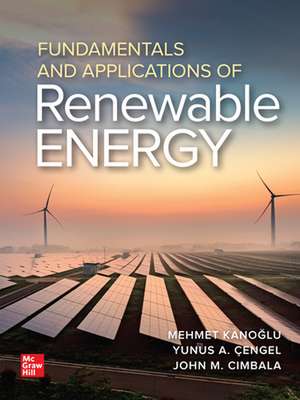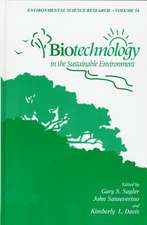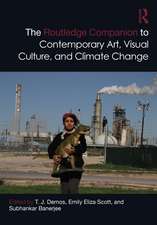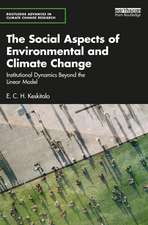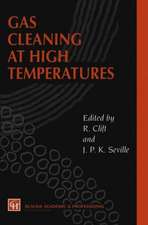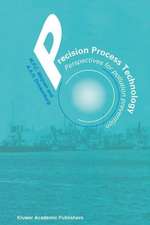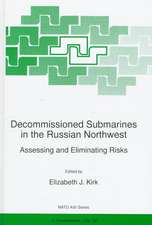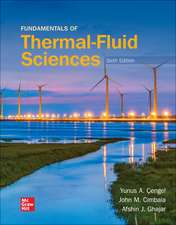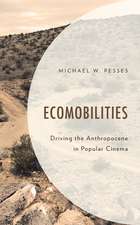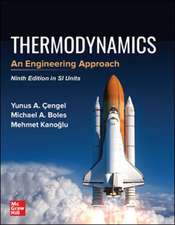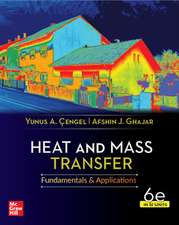Fundamentals and Applications of Renewable Energy
Autor Mehmet Kanoglu, Yunus Cengel, John Cimbalaen Limba Engleză Hardback – 18 mai 2019
Publisher's Note: Products purchased from Third Party sellers are not guaranteed by the publisher for quality, authenticity, or access to any online entitlements included with the product.
Master the principles and applications of today’s renewable energy sources and systems
Written by a team of recognized experts and educators, this authoritative textbook offers comprehensive coverage of all major renewable energy sources. The book delves into the main renewable energy topics such as solar, wind, geothermal, hydropower, biomass, tidal, and wave, as well as hydrogen and fuel cells. By stressing real-world relevancy and practical applications, Fundamentals and Applications of Renewable Energy helps prepare students for a successful career in renewable energy. The text contains detailed discussions on the thermodynamics, heat transfer, and fluid mechanics aspects of renewable energy systems in addition to technical and economic analyses. Numerous worked-out example problems and over 850 end-of-chapter review questions reinforce main concepts, formulations, design, and analysis.
Coverage includes:
•Renewable energy basics
•Thermal sciences overview
•Fundamentals and applications of
Solar energy
Wind energy
Hydropower
Geothermal energy
Biomass energy
Ocean energy
Hydrogen and fuel cells
•Economics of renewable energy
•Energy and the environment
Preț: 600.12 lei
Preț vechi: 706.02 lei
-15% Nou
Puncte Express: 900
Preț estimativ în valută:
114.85€ • 119.46$ • 94.81£
114.85€ • 119.46$ • 94.81£
Carte tipărită la comandă
Livrare economică 14-28 aprilie
Preluare comenzi: 021 569.72.76
Specificații
ISBN-13: 9781260455304
ISBN-10: 1260455300
Pagini: 416
Dimensiuni: 203 x 259 x 26 mm
Greutate: 1.02 kg
Editura: McGraw Hill Education
Colecția McGraw-Hill
Locul publicării:United States
ISBN-10: 1260455300
Pagini: 416
Dimensiuni: 203 x 259 x 26 mm
Greutate: 1.02 kg
Editura: McGraw Hill Education
Colecția McGraw-Hill
Locul publicării:United States
Cuprins
About the Authors
Contents
Preface
Chapter 1 Introduction to Renewable Energy
1-1 Why Renewable Energy?
Consequences of Fossil Fuel Combustion
Renewable Energy Sources
1-2 Fossil Fuels and Nuclear Energy
Coal
Oil
Natural Gas
Nuclear Energy
Electricity
References
Problems
Chapter 2 A Review of Thermal Sciences
2-1 Thermal Sciences
2-2 Thermodynamics
Heat and Other Forms of Energy
Specific Heats of Gases, Liquids, and Solids
Energy Transfer
The First Law of Thermodynamics
Energy Balance for Closed Systems
Energy Balance for Steady-Flow Systems
Saturation Temperature and Saturation Pressure
2-3 Heat Transfer
Conduction Heat Transfer
Thermal Conductivity
Convection Heat Transfer
Radiation Heat Transfer
2-4 Fluid Mechanics
Viscosity
Pressure Drop in Fluid Flow in Pipes
2-5 Thermochemistry
Fuels and Combustion
Theoretical and Actual Combustion Processes
Enthalpy of Formation and Enthalpy of Combustion
First-Law Analysis of Reacting Systems
2-6 Heat Engines and Power Plants
Thermal Efficiency
Overall Plant Efficiency
2-7 Refrigerators and Heat Pumps
References
Problems
Chapter 3 Fundamentals of Solar Energy
3-1 Introduction
3-2 Radiation Fundamentals
Blackbody Radiation
3-3 Radiative Properties
Emissivity
Absorptivity, Reflectivity, and Transmissivity
The Greenhouse Effect
3-4 Solar Radiation
3-5 Solar Data
References
Problems
Chapter 4 Solar Energy Applications
4-1 Introduction
4-2 Flat-Plate Solar Collector
4-3 Concentrating Solar Collector
4-4 Solar-Power-Tower Plant
4-5 Solar Pond
4-6 Photovoltaic Cell
4-7 Passive Solar Applications
Trombe Wall
Solar Heat Gain through Windows
References
Problems
Chapter 5 Wind Energy
5-1 Introduction
5-2 Wind Turbine Types and Power Performance Curve
5-3 Wind Power Potential
5-4 Wind Power Density
5-5 Wind Turbine Efficiency
Betz Limit for Wind Turbine Efficiency
5-6 Considerations in Wind Power Applications
References
Problems
Chapter 6 Hydropower
6-1 Introduction
6-2 Analysis of a Hydroelectric Power Plant
6-3 Impulse Turbines
6-4 Reaction Turbines
6-5 Turbine Specific Speed
6-6 Run-of-River Plants and Waterwheels
References
Problems
Chapter 7 Geothermal Energy
7-1 Introduction
7-2 Geothermal Applications
7-3 Geothermal Heating
Degree-Day Method for Annual Energy Consumption
7-4 Geothermal Cooling
Absorption Cooling System
7-5 Geothermal Heat Pump Systems
Heat Pump Systems
Ground-Source Heat Pump Systems
7-6 Geothermal Power Production
7-7 Geothermal Cogeneration
References
Problems
Chapter 8 Biomass Energy
8-1 Introduction
8-2 Biomass Resources
8-3 Conversion of Biomass to Biofuel
8-4 Biomass Products
Ethanol
Biodiesel
Methanol
Pyrolysis Oil
Biogas
Producer Gas
Synthesis Gas
8-5 Electricity and Heat Production by Biomass
8-6 Solid Municipality Waste
References
Problems
Chapter 9 Ocean Energy
9-1 Introduction
9-2 Ocean Thermal Energy Conversion
9-3 Wave Energy
Power Production from Waves
Wave Power Technologies
9-4 Tidal Energy
References
Problems
Chapter 10 Hydrogen and Fuel Cells
10-1 Hydrogen: An Energy Carrier
10-2 Fuel Cells
Thermodynamic Analysis of Fuel Cells
References
Problems
Chapter 11 Economics of Renewable Energy
11-1 Engineering Economics
11-2 The Time Value of Money
Effect of Inflation and Taxation on Interest Rate
11-3 Life Cycle Cost Analysis
Cost-Benefit Analysis
Unit Product Cost
Comparison of Projects Based on Life Cycle Cost Analysis
11-4 Payback Period Analysis
References
Problems
Chapter 12 Energy and the Environment
12-1 Introduction
12-2 Air Pollutants
Particulate Matter
Sulfur Dioxide
Nitrogen Oxides
Hydrocarbons
Carbon Monoxide
Ozone, Smog, and Acid Rain
12-3 Emissions from Automobiles
Catalytic Converters
12-4 The Greenhouse Effect
CO2 Production
12-5 Stratospheric Ozone Depletion
12-6 Nuclear Waste
References
Problems
Appendix 1 Property Tables (SI Units)
Appendix 2 Property Tables (English Units)
Index
Contents
Preface
Chapter 1 Introduction to Renewable Energy
1-1 Why Renewable Energy?
Consequences of Fossil Fuel Combustion
Renewable Energy Sources
1-2 Fossil Fuels and Nuclear Energy
Coal
Oil
Natural Gas
Nuclear Energy
Electricity
References
Problems
Chapter 2 A Review of Thermal Sciences
2-1 Thermal Sciences
2-2 Thermodynamics
Heat and Other Forms of Energy
Specific Heats of Gases, Liquids, and Solids
Energy Transfer
The First Law of Thermodynamics
Energy Balance for Closed Systems
Energy Balance for Steady-Flow Systems
Saturation Temperature and Saturation Pressure
2-3 Heat Transfer
Conduction Heat Transfer
Thermal Conductivity
Convection Heat Transfer
Radiation Heat Transfer
2-4 Fluid Mechanics
Viscosity
Pressure Drop in Fluid Flow in Pipes
2-5 Thermochemistry
Fuels and Combustion
Theoretical and Actual Combustion Processes
Enthalpy of Formation and Enthalpy of Combustion
First-Law Analysis of Reacting Systems
2-6 Heat Engines and Power Plants
Thermal Efficiency
Overall Plant Efficiency
2-7 Refrigerators and Heat Pumps
References
Problems
Chapter 3 Fundamentals of Solar Energy
3-1 Introduction
3-2 Radiation Fundamentals
Blackbody Radiation
3-3 Radiative Properties
Emissivity
Absorptivity, Reflectivity, and Transmissivity
The Greenhouse Effect
3-4 Solar Radiation
3-5 Solar Data
References
Problems
Chapter 4 Solar Energy Applications
4-1 Introduction
4-2 Flat-Plate Solar Collector
4-3 Concentrating Solar Collector
4-4 Solar-Power-Tower Plant
4-5 Solar Pond
4-6 Photovoltaic Cell
4-7 Passive Solar Applications
Trombe Wall
Solar Heat Gain through Windows
References
Problems
Chapter 5 Wind Energy
5-1 Introduction
5-2 Wind Turbine Types and Power Performance Curve
5-3 Wind Power Potential
5-4 Wind Power Density
5-5 Wind Turbine Efficiency
Betz Limit for Wind Turbine Efficiency
5-6 Considerations in Wind Power Applications
References
Problems
Chapter 6 Hydropower
6-1 Introduction
6-2 Analysis of a Hydroelectric Power Plant
6-3 Impulse Turbines
6-4 Reaction Turbines
6-5 Turbine Specific Speed
6-6 Run-of-River Plants and Waterwheels
References
Problems
Chapter 7 Geothermal Energy
7-1 Introduction
7-2 Geothermal Applications
7-3 Geothermal Heating
Degree-Day Method for Annual Energy Consumption
7-4 Geothermal Cooling
Absorption Cooling System
7-5 Geothermal Heat Pump Systems
Heat Pump Systems
Ground-Source Heat Pump Systems
7-6 Geothermal Power Production
7-7 Geothermal Cogeneration
References
Problems
Chapter 8 Biomass Energy
8-1 Introduction
8-2 Biomass Resources
8-3 Conversion of Biomass to Biofuel
8-4 Biomass Products
Ethanol
Biodiesel
Methanol
Pyrolysis Oil
Biogas
Producer Gas
Synthesis Gas
8-5 Electricity and Heat Production by Biomass
8-6 Solid Municipality Waste
References
Problems
Chapter 9 Ocean Energy
9-1 Introduction
9-2 Ocean Thermal Energy Conversion
9-3 Wave Energy
Power Production from Waves
Wave Power Technologies
9-4 Tidal Energy
References
Problems
Chapter 10 Hydrogen and Fuel Cells
10-1 Hydrogen: An Energy Carrier
10-2 Fuel Cells
Thermodynamic Analysis of Fuel Cells
References
Problems
Chapter 11 Economics of Renewable Energy
11-1 Engineering Economics
11-2 The Time Value of Money
Effect of Inflation and Taxation on Interest Rate
11-3 Life Cycle Cost Analysis
Cost-Benefit Analysis
Unit Product Cost
Comparison of Projects Based on Life Cycle Cost Analysis
11-4 Payback Period Analysis
References
Problems
Chapter 12 Energy and the Environment
12-1 Introduction
12-2 Air Pollutants
Particulate Matter
Sulfur Dioxide
Nitrogen Oxides
Hydrocarbons
Carbon Monoxide
Ozone, Smog, and Acid Rain
12-3 Emissions from Automobiles
Catalytic Converters
12-4 The Greenhouse Effect
CO2 Production
12-5 Stratospheric Ozone Depletion
12-6 Nuclear Waste
References
Problems
Appendix 1 Property Tables (SI Units)
Appendix 2 Property Tables (English Units)
Index
